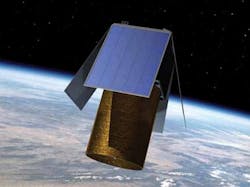Army taps Quantum Research to build imaging nano-satellites for front-line warfighters
Officials of the Army Strategic Command at Peterson Air Force Base, Colo., announced their intention this week to award a contract worth about $8.5 million to Quantum Research to build and demonstrate Kestrel Eye satellite technology and ground-control equipment.
The Kestrel Eye Visible Imagery Nanosatellite Technology Demonstration program seeks to develop a small, low-cost, visible imagery satellite demonstrator that offers Army warfighters with on-demand real-time satellite imagery.
The Kestrel Eye electro-optical nano-satellite will be able to produce images of 1.5-meter resolution that can be downlinked to front-line warfighters. The idea is to demonstrate a tactical nanosat that could be built in large numbers to provide persistent-surveillance capability to ground forces.
Army officials would like the capability to produce high-resolution satellite images and downlink them to front-line warfighters within 10 minutes.
The Kestrel Eye program will extend the unmanned aerial vehicle (UAV) paradigm into space, Army officials say. The eventual goal is to provide persistent coverage to every soldier on a hand-held device about the size of today's GPS receivers. The idea is to enable soldiers to click on any point of the ground displayed on a world map and call up real-time imagery of the area.
The upcoming contract to Quantum Research will ask the company to complete Kestrel Eye satellites that are under development, and provide satellite demonstration and support.
The Kestrel Eye reconnaissance satellite program is part of a larger initiative called Concepts and Operations for Space and Missile Defense Integration and Capabilities (COSMIC), which Quantum Research and BAE Systems are contractors.
More information on the Kestrel Eye program and the upcoming contract to quantum Research is online at https://www.fbo.gov/notices/92289bec2f10558f90130a7815da3797.
For additional information contact Quantum Research International online at www.quantum-intl.com, or the Army Strategic Command at www.army.mil/info/organization/unitsandcommands/commandstructure/smdc.
